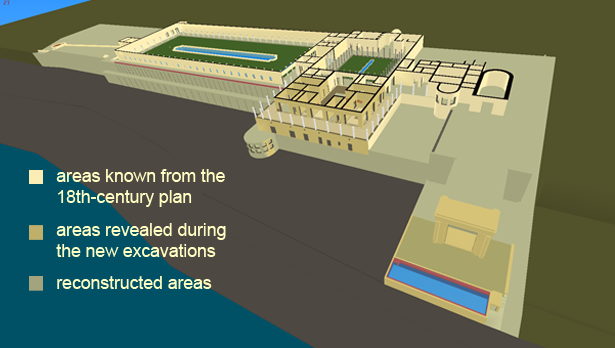At a lecture hosted by the Friends of ANU Classics Museum (Canberra, Australia) in September, I learnt about the Villa of the Papyri.
Imagine a villa so big that parts of it haven’t been uncovered yet and big enough to house over 90 sculptures and other artefacts. This villa can be found in what was once the ancient Roman city of Herculaneum, and today is in a half-excavated dig site near the Gulf of Naples.

The story goes that Herculaneum was first discovered in 1709 by an Austrian Prince who wanted to dig a well in the garden of his palace. Since then there has been a string of excavations to uncover ancient Herculaneum that had been buried under modern urban planning.
When first excavating in the 1730s, wells were dug straight down and any treasures located where hoisted up through the wells. In this way, the, then ‘King of Naples‘ Charles III, expanded his entirely unique collection of antiques. They gave him prestige among his peers as the only monarch with access to such treasures. It was in 1750 that the Villa of the Papyri was discovered to the side of ancient Herculaneum. At first, the villa was thought to be just a series of smaller houses. However, through the work of Karl Weber, a Swiss engineer acting on behalf of Rocque Joaquín de Alcubierre the vastness of the villa was brought to light.
The villa’s front stretched for more than 250 meters, parallel to the coastline and remains faithful to the general layout and architectural scheme of a Roman home. The atrium functioned as an entrance hall and a gateway to various parts of the house. The first peristyle has 10 columns on each side and a swimming bath in the centre. A larger second peristyle could be reached by passing through a tablinum. The living areas were grouped around the porticoes and terraces, this gave occupants ample sunlight and a view of the countryside and sea.

Model showing the areas of the Villa discovered at various time. 2012. Created by Mantha Zarmakoupi
It is only after six years of systematic work by Weber that we have such a detailed idea of the size and dimensions of the villa. Even today, modern archaeologist still use Weber’s work for continued excavations. Weber used tunnels to expose parts of the villa and to retrieve its treasures. He also had the job of making these tunnels safe for visiting dignitaries to walk through, as the King of Naples enjoyed showing off Herculaneum and later on the Villa of the Papyri. There are accounts of people visiting the tunnels as early as 1740 only two short years after excavations first began.

Excavated tunnel in Palaestra, Herculaneum. 2013. Taken by Digital Nigel
What has given this villa its name is the thousands of papyrus scrolls that were found within it from 1752 onwards. The King who funded excavations at Herculaneum only wanted unique items for his growing collection of antiquities. So at first these scrolls were thrown out because of their great number. Eventually, it was on the advice of Bernardo Tanucci that the King created a commission to study the texts. Early attempts to unroll the scrolls resulted in their destruction. Yet, progress was made using an “unrolling device” invented by the Piarist monk, Antonio Piaggio, who was sent from Rome expressly for the purpose of helping to decipher the scrolls.

Rolled and unrolled scrolls from the Villa of the Papyri. By Peter and Michael Clements
The continuing debate regarding the Villa of the Papyri is that we have only found half of the library a villa this size would be expected to hold. Most Roman villas would have two libraries, one Greek and one Roman covering a variety of topics. Of the scrolls that have been unrolled and deciphered there seems to be only one topic – Epicurean philosophy – which leads experts to think we have found the Greek library, so where is the Roman one? Furthermore, the lack of variety in the scrolls we have uncovered makes the library of this villa even more of a mystery.
Which leaves us with one big question: do we excavate more of the Villa of the Papyri to unlock the secrets of the library or focus our attention of finding a better way to read what we currently have? Personally, I am more inclined to discover what the thousands of papyri we already have say. Considering their extremely fragile state, digging up more will only cost more in terms of conservation and storage. But there are some like Richard Janko, professor of classical studies at the University of Michigan who think differently.
He reasons this by the fact the villa belonged to Latin-speaking Roman aristocrats, Lucius Calpurnius Piso and his son – so there would be a Latin library as well as the mostly Greek library already discovered. Also, Janko believes the villa was a “mouseion—a museum-like place to show off a collection of spectacular works of art and literature. If this mouseion had literature to compare to its sculptures, we should expect something more impressive than the working collection of a minor philosopher such as Philodemus. We might even hope for an early edition of the Aeneid, as Virgil and Philodemus knew each other” (BBC News Magazine).
So what are your thoughts, to dig, or not to dig?
Further Reading
- Unlocking the scrolls of Herculaneum – BBC News Magazine
- A Virtual Model of the Villa dei Papiri – Mantha Zarmakoupi
- Herculaneum Papyri before Unrolling – UCLA Department of Classics
- The Herculaneum Library: some recent developments – R. Janko
- Destruction and Re-discovery – Peter and Michael Clements
- The Charred Scrolls of Herculaneum – Archeaology
- Blogging Pompeii